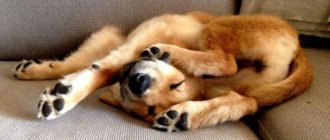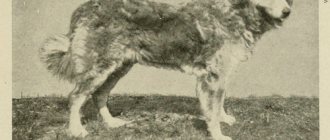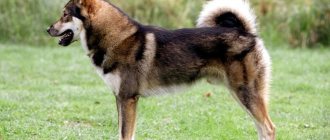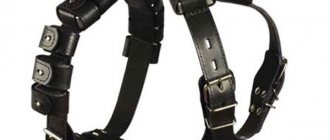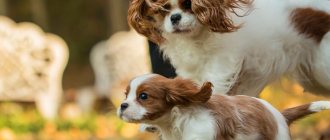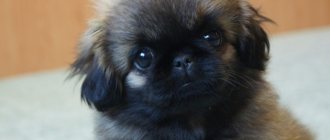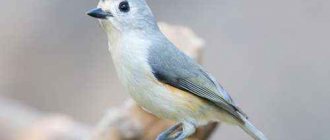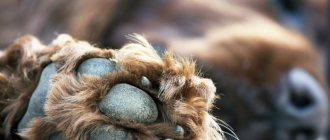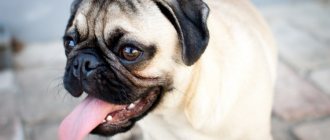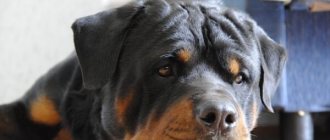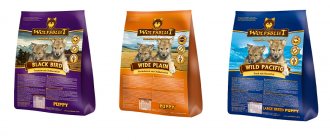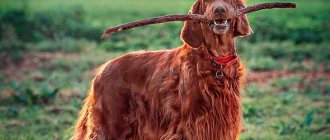For many years, people have been trying to subjugate the forces of nature and wild animals. Numerous attempts to tame the wolf have ended in failure. But scientists don't give up. The Northern Inuit Dog is a hybrid pet with the appearance of a wolf and the character of a peace-loving companion dog, which was created in a laboratory.
- 2 Unofficial breed standard
2.1 Character of the northern wolf-like pet
- 5.1 Video: Northern Inuit dog being brushed while shedding
5.3.1 Video: Northern Inuit dog plays with owner
Historical reference
Attempts to get a dog with the appearance of a wolf, but the character of a domestic companion, were made several times, but success was not achieved for a long time. The created hybrids were not amenable to training and socialization.
Surprisingly, the amazing direwolves actually exist.
However, luck still smiled on the dog handlers - in the 80s of the 19th century they managed to get an Inuit dog. This is a beautiful animal in all respects with a bright appearance, but surprisingly good-natured.
There are several theories about the origin of the breed:
- Created by Eddie Garison by crossing Siberian Huskies, German Shepherds and Alaskan Malamutes.
- Appeared as a result of spontaneous crossing of an Eskimo dog with a German shepherd and a Malamute.
Note! Despite their appearance, the Iniuts do not have a drop of wolf blood.
England is considered the historical homeland. At the moment, a representative of the breed is not recognized by the International Canine Organization, but a few fans are engaged in breeding.
Diseases of the breed
In dogs, the creation of which involved aboriginal “mongrels” and purebred dogs, it is very difficult to accurately determine the diseases characteristic of this breed. Since the population of these dogs is small, there are no official statistics on diseases.
The most common pathologies of Inuit dogs include:
- hip dysplasia;
- dislocation of the elbow joint;
- glaucoma;
- epilepsy;
- Addison's disease;
- degenerative
- chondrodysplasia;
- cancer.
Dogs with chondrodysplasia are difficult to identify before 6 weeks of age, even by an experienced veterinarian without x-rays. Outwardly completely normal parents can pass on the “damaged” gene.
Puppies received from foreign nurseries have not only a mandatory vaccination card, but also x-rays confirming the absence of signs of chondrodysplasia and joint dysplasia.
A selection of interesting facts
Dog with folds: wrinkled pet breed
The Inuit direwolf is a strong and attractive dog, with several interesting facts associated with it:
- Actress Sophie Turner, who played the role of Sansa Stark on screen, took one of these dogs for herself after filming the saga.
- The dog is very dynamic, so it needs constant physical activity.
- She sheds a lot, so she needs regular brushing. If there is no time for proper care, a representative of the breed should be abandoned.
- The dog is very sociable, loves the company of people and gets along well with other dogs, especially if they grow up together.
- They are distinguished by extraordinary mental abilities.
Of course, interest in the breed is largely due to the participation of dogs in the filming of the series, but do not forget that these are really smart and beautiful pets.
Inuit dogs are beautiful and smart, resembling a wolf in appearance
Description of the Inuit dog
As already mentioned, the Inuit is very similar to the wolf. The dog is quite large, athletic, and almost never gains more than its average weight. The height of the dog at the withers is from 60 to 85 cm, the average weight for males is up to 50 kg and for females up to 40 kg.
He is distinguished by athletic muscles, a toned stomach and strong legs. The limbs are well developed, smooth with large joints. The joints are directed backwards, without depressions or displacements. The paws are large, grouped together. The claws are very strong, bent back.
The Inuit's tail is completely straight; any bends or bends are a defect. The dog's head is wedge-shaped with a low forehead. The jaw is developed, a full-fledged correct bite. The nose is medium in size with open nostrils. The color always depends on the color; the lighter the pet, the lighter the nose.
The eyes are slightly slanted and not large. The color can be different, but most often the pigment of the eyes matches the color of the nose. The ears are quite large, set low and not widely apart.
The Inuit's coat is short, double and hard. It has a thick undercoat that fits tightly to the body. The color is not very varied, it can be white, black. Sometimes there is a sable pattern on the main color. Other colors are not typical for this breed. Previously, belonging to this type of dog indicated the obligatory presence of a white mask on the face for any color other than pure black.
However, recently animals with such a characteristic feature appear less and less often, but this does not prevent qualified dog breeders from recognizing such dogs as pedigree. Today the breed is quite in demand all over the world.
Coat and possible colors
Inuit wool is double wool, which protects well from frost, wind, and moisture. It is rough to the touch, with straight guard hairs. The undercoat is dense and well developed. The length of the coat is medium, the same length throughout the body, only on the neck, limbs and tail it is slightly longer.
The most popular dogs are wolf-colored, but the following are allowed:
pure white;
- solid black;
- sable - from peach to gray;
- black-gray;
- grey-red;
- black and tan;
- reddish-brown with saddle cloth.
The color transition is smooth. Stains are not acceptable. Until recently, a “wolf mask” was mandatory, but today dogs without a characteristic mask are also recognized by experts as purebred.
Unofficial breed standard
The Inuit is a dog that is not officially recognized, so the standard is informal. The representative of the breed is distinguished by a muscular, lean physique, with a muzzle tapering towards the tip of the nose.
Podenco Ibicenco breed (Ibizan Greyhound)
The description of the Northern Inuit dog is as follows:
- the nose is black, lack of pigmentation is allowed for white animals;
- scissor bite;
- eye color options: brown, amber, yellow, blue;
- erect triangle ears;
- claws black or dark gray, with hard pads;
- The coat is straight, coarse, with a pronounced undercoat.
The color options are different: wolf (wild), white, black, brown-red, black and white. The presence of stains, including silver, is not allowed. The average weight of a male is 40-50 kg, females - 26-40 kg. Height at the withers for males is 59-80 cm, for females – 58-70 cm.
Note! Representatives of the breed are not predisposed to obesity.
Description of the species
The dogs are large. Their height ranges from 59-76 centimeters with a weight of 25-50 kilograms. Naturally, the male will always be larger. The female's character is a little calmer, but don't expect an angelic character; after all, a wild relative is taken as a basis.
The animal's head is wedge-shaped and dry. Her low and flat forehead blends smoothly into her muzzle. The bridge of the nose is half the length of the head itself. The nose itself is large. It can be highlighted or, on the contrary, darkened. The Inuit have a full-toothed and regular bite.
The dog's eyes are dark, almond-shaped, covered by eyelids that fit tightly. The animal's ears are large. They are low set and well covered. The body of the northern Inuit is flowing, rectangular in shape. It is supported on strong and straight limbs. The powerful sickle-shaped tail is freely lowered.
The breed is characterized by coarse hair and a dense undercoat. Its shades are different. There are white and black, different variations of sable.
Pet Personality Traits
A representative of the breed will make a wonderful companion dog. It becomes attached to the owner and members of his family, but is somewhat stubborn. It is important that the dog perceives its owner as the leader of the pack, only in this case will it obey. This is why Inuits are strictly not recommended as pets for novice dog owners.
Commander (dog): Hungarian shepherd breed
Inuit are loyal, active, dynamic dogs, and can hardly tolerate loneliness, so those who have to constantly go on business trips should give up such a dog. The developed pack instinct allows this animal to be kept with other pets, including cats. It may seem that the pet is a real intuitive, since it understands the owner’s mood and tries to match it.
Note! If you leave a dog alone for a long time, it will howl and whine, so problems with neighbors may arise.
The Northern Inuit dog is an animal that needs a strong-willed owner
Life
Eskimos form communities that include residents of one settlement (winter). They consist of many families in which everyone has certain duties. A family can include not only a husband and wife and their children, but also immediate relatives. Several families often live in one dwelling. Married couples sleep with their children in the center of the house. Lonely members of the community take seats at the edges. For the most part, marriages are monogamous, with each man having one wife. However, no one forbids him to marry two girls or get a divorce. But this rarely happens, since the way of life of the people is aimed at preserving the well-being of the family and society as a whole.
The Eskimo way of life involves close cooperation, which requires high consciousness from each member of society. They hunt together and use items belonging to the entire village. Residents constantly communicate with each other, there are unspoken laws between them. The postulates are expressed in the following rules:
- Strangers do not have the right to build a house inside the settlement without the consent of all its residents.
- Each settler takes a certain small portion of the spoils for himself. In this case, the members of the successful hunter’s family receive the meat and fish first. Thanks to this, none of the villagers go hungry.
- Each person can live and hunt outside the community if he wants.
- If someone finds any objects or things and their owner is not found, the finder takes them for himself.
- When none of the hunters have any luck in the hunt for a long time, the richest families invite others to dine with them.
The Eskimos do not have any self-government organizations. All problems are discussed within society and resolved immediately. Scandals and quarrels on any occasion are prohibited. This rule is dictated by the need for peaceful coexistence in a small territory. The languages of these peoples do not have swear words. With this way of life, there is practically no crime among the population. If a murder occurs (which is extremely rare), this requires retaliation according to the law of blood feud. The person who committed this act must be killed by a relative of the person killed. When vengeance is taken, relatives are notified.
Training and education
Training and socialization of an Inuit should begin from an early age, otherwise an adult dog will demonstrate character and disobey its owner. The dog is very smart, however, like many animals with Eskimo-Alaskan roots, it is willful and rebellious. With the right approach to training, he can not only master a basic set of skills, but also learn several complex tricks.
Note! You cannot use rudeness or physical violence against a representative of the breed.
Temperament
Dogs of this breed are loyal, strong, brave, intelligent and very loyal. When used as mounts, they often require food; In addition, they often hunt for their own food. Consequently, many Canadian Inuit dogs have stronger hunting instincts than some other breeds. They can sleep outside in cold climates.
Breeders from their practice say that the Canadian Eskimo dog has a tough character, but at the same time it is a very hardworking breed. The dog was originally domesticated by the Inuit to perform certain tasks in the harsh arctic environment, which influenced the development of its character.
Representatives of the breed love attention and can be gentle (they respond to every stimulus with pleasure, be it a response to food, work, an invitation from “brothers” to go fight or play)
In the case of timely socialization of the animal, dogs usually show quite “quiet” friendliness and “safe” curiosity with strangers, or become completely distant from them.
The dog is well controlled. Fearless in relation to wild animals (there is evidence that while traveling in a sled over long distances, the Canadian Eskimo dog scared away polar bears and wolves, protecting its owners). In view of this, sometimes representatives of this breed can be seen with a sufficient number of battle scars or torn ears, which is a consequence of fights or “showdowns” when gathering in a group.
Breeders recommend that the Canadian Eskimo Dog be considered a companion for adults, and not considered a pet as a child in the home.
Features of maintenance and care
The direwolf is a breed of dog that is easy to care for. However, due to the lush undercoat, it is necessary to comb your pet regularly. Basic care procedures include:
- Wash 1-2 times a year using zoo shampoo.
- Combing - at least once a week, during the molting period - every other day.
- Nail trimming – 2 times a month.
- Brushing your teeth – 2 times a month.
Note! The pet sheds so much that it is preferable to keep it outside.
When choosing a nickname, you can be guided by your taste. For example, a pet can be named Mr. Parker, Ghost, Rich, Dick, Harry. Suitable names for a girl dog are Evelina, Gerda, Gloria, Goldie, Ada. The main thing is that the chosen nickname is liked by the dog and the owner.
Kamchatka sledding
The specificity of the breed is that it was created by nature itself, without human intervention, several thousand years ago. This fact is confirmed by archaeological excavations. Now this aboriginal breed, the standard of which was developed and adopted in our country in 1992, is on the verge of extinction. Enthusiastic dog breeders are trying to revive it in special nurseries using their descendants - Alaskan huskies.
Laikas, exemplary for the conditions of Kamchatka, are very loyal, smart and resourceful in difficult situations. There are many cases where dogs rescued their owner in a snowstorm, digging out the sled and delivering it home. They are patient, balanced and hardworking, obedient and ready to carry out the instructions of the owner.
Catering
It is very important to offer your pet quality food. It is allowed to feed the Inuit with premium ready-made industrial food aimed at dogs with allergies. Puppies are fed three times a day, adult dogs - 2 times a day.
Note! The basis of the diet is protein food (1/2 serving), up to 15% should be fat.
To keep the Inuit dog healthy and active, he is offered lean meat, fish once a week, vegetables, and dairy products. Chicken can cause allergies, so you should not give it.
Snow white dogs need quality feeding to maintain health.
Tips for choosing a puppy
As a rule, potential owners are deprived of the opportunity to make a choice, since the breed is very rare; puppies are sold only in nurseries in the UK. However, when purchasing such an expensive animal, it is imperative that the parents familiarize themselves with the pedigree and medical documents, and, if possible, observe their pet.
Becoming the owner of your own direwolf is not easy, since there are no nurseries in Russia yet
If a personal visit is not possible, you can ask the nursery representatives to conduct an online broadcast or send a series of photos or videos.
Inuit is an active animal, puppies should be playful and curious. If a dog is huddled in a corner and does not want to play with its friends, this is an unkind sign and most often indicates health problems.
Where to buy a puppy, price question
Since there is not a single official kennel in the Russian Federation, buying an Inuit puppy will not be easy. The only reliable option is to order a pet from the UK, but the cost will be quite high. There are long queues for representatives of this rare breed; puppies are reserved even before birth.
The average price of a pet is from 30 thousand rubles*.
Note! Transportation costs are also paid additionally.
Representatives of the breed will obey only the owner who is considered the leader of the pack
These are the characteristics of the northern Inuit dog, a rare breed that is gradually conquering the world of cynology.
*Price is valid for January 2020
Purpose
Huskies can be used as a sled dog and as a companion. Many fanciers get several dogs of this breed at once in order to form a full-fledged team for participation in competitions.
But even one husky dog can keep you company on a hike in the mountains or on a winter ski trip. Thanks to her goodwill and charm, the ability to make independent decisions in a difficult situation and high intelligence, the husky has become an excellent pet.
Does it apply to riders?
The large snow-covered expanses of Siberia, where frosts are off the charts, and sparsely populated areas have created a need for such a dog. A strong, devoted and reliable assistant who will help, understand, support and save in the incredibly difficult living conditions of humans in the northern regions. The Chukchi were able to train this animal to Husky, hence the name of the Eskie breed from the American Husky.
This and only this was its main purpose. Transport cargo over vast distances, despite the cold and raging snowstorms.
The Americans appreciated this breed of sled dogs, took them to Alaska and placed them on a podium and turned them into a national treasure of America. And she deserves it, and so that they don’t forget where she came from, they called her Siberian.
During the “gold rush” in the 30s, this dog, so similar to a wolf and so friendly to humans, could not help but arouse admiration, steadfastly enduring, together with humans, all the hardships and hardships of camp life in the harsh climate of the Far North.
Eskimo sled dogs have long been bred to help people who fished and hunted. Usually, for a good team, at least 9 dogs were used, and they were fed dried fish. Dogs were never divided into the categories of sled dogs, hunting dogs, or reindeer dogs and were used as universal dogs.
Hunting breed or not?
Feeding northern aboriginal dogs still retains its unusual nature. The animals feed by hunting; as soon as the snow melts, the team is released into the wild. Thanks to this, all such dogs have a highly developed hunting instinct, but whether they are suitable for hunting is a somewhat controversial issue. And although it is, of course, possible to interest them, and the dogs hunt, they will not bring prey to the owner.
Their diet includes field mice, small birds, and sometimes a Husky can catch up with a hare and tear it to pieces. And if Huskies unite in a pack, they can drag away a goat.
Such hunting instincts often lead to dogs, as predators, attacking cats and killing them, although if they grew up with cats in the house, they do not touch them. This feature of Husky behavior often leads to conflicts with neighbors.
Is it suitable as a security guard for a private home?
Watchdog and security qualities are completely absent from these dogs. Too friendly, showing incredible sympathy, without obvious aggression towards strangers. And a Husky will not be a watchman, since they do not have the instinct to protect their territory. For protection, it is better to choose another breed.
Can he be a defender?
An ordinary Siberian Husky cannot be a protector of the home and owner, unless it is a breed bred in Japan (Akita Inu).
Breeding for sport
Siberian Huskies have had high driving qualities for many years, but time does not stand still. And to breed dogs with higher racing speeds, mixed breeds appeared. There was a mixing of various breeds of hounds and pointing breeds with purebred Huskies.
The resulting dog breeds led to the fact that, while maintaining the advantages of this dog breed, they showed much greater speed as sled dogs in sports. Purebred Huskies still participate in sports races, but they lose greatly to mixed breeds - Alaskan Huskies. The Alaskan Husky is an athletic, very fast and resilient dog.
